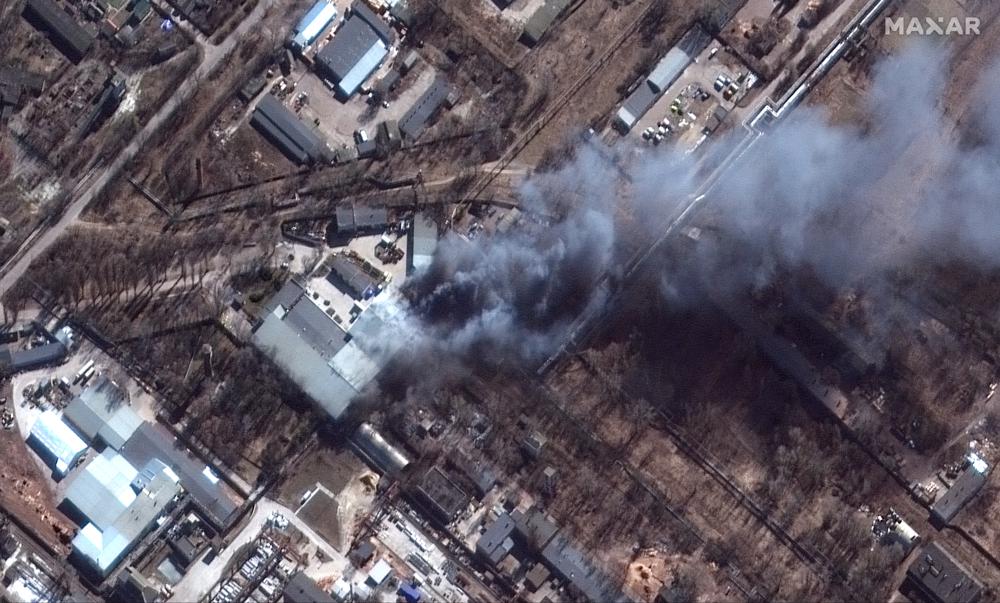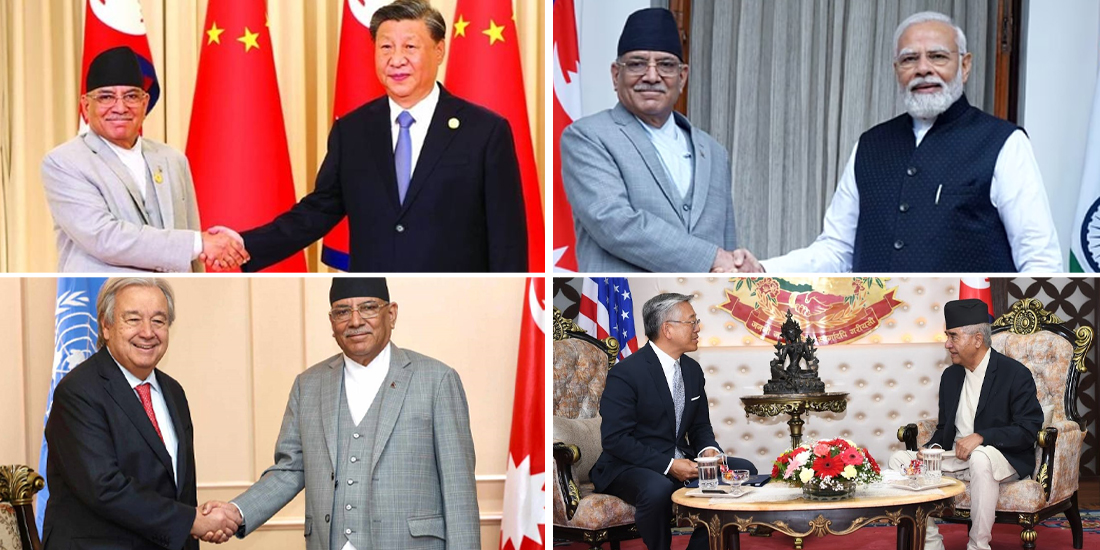Russian strikes hit western Ukraine as offensive widens
 NepalPress
NepalPress

Russia widened its military offensive in Ukraine on Friday, striking near airports in the west of the country for the first time, as observers and satellite photos indicated that its troops, long stalled in a convoy outside the capital Kyiv, were trying to maneuver to encircle the city, Associated Press reported.
With the invasion now in its third week, the U.S. and its allies prepared to step up their efforts to isolate and sanction Russia by revoking its most favored trading status. The move comes amid mounting outrage after a deadly airstrike hit a maternity hospital in the key Ukrainian port city of Mariupol, under an increasingly constricting 10-day-old siege.
The new airstrikes in western Ukraine were likely a message from Russia that no area was safe, Western and Ukrainian officials say Russian forces have struggled in the face of heavier-than-expected resistance and supply and morale problems. So far, they have made the most advances on cities in the south and east while stalling in the north and around Kyiv.
Strikes on the western Lutsk airfield killed two Ukrainian servicemen and wounded six people, according to the head of the surrounding Volyn region, Yuriy Pohulyayko. In Ivano-Frankivsk, residents were ordered to shelters after an air raid alert, Mayor Ruslan Martsinkiv said.
Russian Defense Ministry spokesman Igor Konashenkov said Russia used high-precision long-range weapons Friday to put military airfields in Lutsk and Ivano-Frankivsk “out of action.” He did not provide details.
New satellite photos, meanwhile, appeared to show a massive Russian convoy outside the Ukrainian capital had fanned out into towns and forests near Kyiv, with artillery pieces raised for firing in another potentially ominous movement.
The 40-mile (64-kilometer) line of vehicles, tanks and artillery had massed outside the city early last week, but its advance appeared to stall as reports of food and fuel shortages circulated. U.S. officials said Ukrainian troops also targeted the convoy with anti-tank missiles.
The satellite imagery, from Maxar Technologies, showed the 40-mile (64-kilometer) line of vehicles, tanks and artillery outside Kyiv had been redeployed, the company said. Armored units were seen in towns near the Antonov Airport north of the city. Some vehicles moved into forests, Maxar reported, with towed howitzers nearby in position to open fire.
It appeared the convoy forces were moving west around the city, trying to encircle it to the south, according to Jack Watling, a research fellow at a British defense think-tank, the Royal United Services Institute. “They’re about half-way around now, to be able to close off on the south,” he told BBC radio.
He said they were likely preparing for a “siege rather than assault” on Kyiv because of continuing low morale and logistical problems.
The British Ministry of Defense said that after making “limited progress” because of logistical mishaps and Ukrainian resistance, Russian forces were trying to “re-set and re-posture” their troops, gearing up for operations against Kyiv.
Moscow also gave new indications that it plans to bring fighters from Syria into the conflict.
Russian Defense Minister Sergei Shoigu said Russia knew of “more than 16,000 applications” from countries in the Middle East, many of them from people who he said had helped Russia against the Islamic State group, according to a Kremlin transcript.
Shoigu did not specify Syria and his numbers could not be confirmed. But since 2015, Russian forces have backed Syrian President Assad against various groups opposed to his rule, including Islamic State.
Responding to Shoigu, President Vladimir Putin approved bringing in “volunteer” fighters and told his defense minister to help them “move to the combat zone.”
Increasing the pressure on Moscow, the U.S. and other nations were poised later Friday to announce the revocation of Russia’s “most favored nation” trade status, which would allow higher tariffs to be imposed on some Russian imports. Western sanctions have already dealt a severe blow to Russia, causing the ruble to plunge, foreign businesses to flee and prices to rise sharply.
Russian airstrikes also targeted for the first time the eastern city of Dnipro, a major industrial hub and Ukraine’s fourth-largest city in a strategic position on the Dnieper River. Three strikes hit early Friday, killing at least one person, according to Ukrainian Interior Ministry adviser Anton Heraschenko.
The head of the Kyiv Region administration, Oleksiy Kuleba, said a missile hit the town of Baryshivka, about 20 kilometers east of Kyiv’s main international Boryspil Airport. He reported significant damage to residences but no immediate casualty toll.
In Syria, Russia backed the government in imposing long, brutal sieges on opposition-held cities, wreaking heavy destruction on residential area and causing widespread civilian casualties.
That history — along with the ongoing siege of the Azov Sea port of Mariupol — has raised fears of similar bloodshed in Ukraine.
Russian Defense Ministry spokesman Igor Konashenkov said Russian-backed fighters have advanced up to 800 meters of Mariupol from the east, north and west, further squeezing the city which has the Azov Sea to its south. Konashenkov said the advance was being conducted by fighters from the separatist-held Donetsk region, the standard Russian line for fighting in the east.
Ukrainian authorities are planning to send aid to Mariupol, home to some 430,000, Ukrainian Deputy Prime Minister Iryna Vereshchuk said in a video message.
Repeated previous attempts have failed as aid and rescue convoys were targeted by Russian shelling, even as residents have grown more desperate, scrounging for food and fuel.
More than 1,300 people have died in the city’s 10-day siege, Vereshchuk said. “They want to destroy the people of Mariupol. They want to make them starve,” she added. “It’s a war crime.”
Residents have no heat or phone service, and many have no electricity. Nighttime temperatures are regularly below freezing, and daytime ones hover just above it. Bodies are being buried in mass graves. The streets are littered with burned-out cars, broken glass and splintered trees.
“They have a clear order to hold Mariupol hostage, to mock it, to constantly bomb and shell it,” Ukrainian President Volodymyr Zelenskyy said in his nightly video address to the nation Thursday. He said the Russians began a tank attack right where there was supposed to be a humanitarian corridor.
Grocery stores and pharmacies were emptied days ago by people breaking in to get supplies, according to a local official with the Red Cross, Sacha Volkov. A black market is operating for vegetables, meat is unavailable, and people are stealing gasoline from cars, Volkov said.
Places protected from bombings are hard to find, with basements reserved for women and children. Residents, Volkov said, are turning on one another: “People started to attack each other for food.”
Vereshchuk also announced efforts to create new humanitarian corridors to bring aid to people in areas occupied or under Russian attack around the cities of Kherson in the south, Chernihiv in the north and Kharkiv in the east.
Some 2.5 million people have fled Ukraine since the invasion began, the International Organization for Migration said Friday. Some 100,000 people have been evacuated during the past two days from seven cities under Russian blockade in the north and center of the country, including the Kyiv suburbs, Zelenskyy said.
In addition to those who have fled the country, millions have been driven from their homes. Kyiv Mayor Vitali Klitschko said about 2 million people, half the metropolitan area’s population, have left the capital.
“Every street, every house … is being fortified,” he said. “Even people who in their lives never intended to change their clothes, now they are in uniform with machine guns in their hands.”














